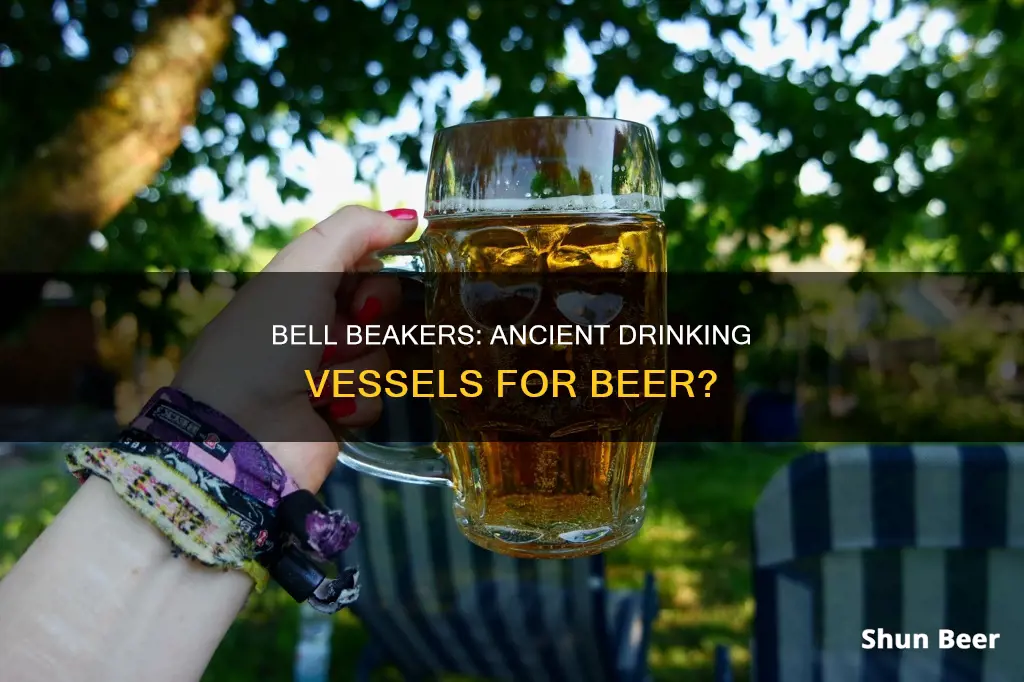
The Bell Beaker culture, also known as the Bell Beaker complex or Bell Beaker phenomenon, is an archaeological culture named after the inverted-bell beaker drinking vessel used at the very beginning of the European Bronze Age, arising around 2800 BC. The Bell Beaker culture spanned various regions, from Britain (c. 2450 BC to 1800 BC) to continental Europe (until about 2300 BC), encompassing areas such as Iberia, the Danubian plains, and northward to the British Isles and Ireland, and even reaching Sardinia, Sicily, and parts of North Africa.
The Bell Beaker phenomenon is renowned for its substantial regional variation, reflecting a mosaic of culturally and genetically diverse populations. A study from 2018 highlighted this genetic diversity, suggesting a complex demographic history.
The Bell Beaker culture intersected and coexisted with other prominent European archaeological cultures. It was partly preceded by and contemporaneous with the Corded Ware culture, and in north-central Europe, it was preceded by the Funnelbeaker culture.
The Bell Beaker artefacts are distinguished by their two main styles: the All Over Ornamented (AOO) and the Maritime type. These artefacts, thought to be designed for alcohol consumption, varied in use, including as reduction pots for smelting copper ores, food containers, and funerary urns. They were also symbols of status among diverse elites.
Traditionally, Bell Beakers have been said to contain alcoholic beverages which were consumed in the course of male feasting ceremonies. However, whilst beer and mead have been identified from certain examples, not all Beakers were drinking cups.
| Characteristics | Values |
|---|---|
| Time Period | Around 2800 BC |
| Area | Britain, Continental Europe, Iberia, Danubian Plains, British Isles, Ireland, Sardinia, Sicily, North Africa |
| Uses | Drinking alcoholic beverages, reduction pots to smelt copper ores, food containers, funerary urns |
| Drinking Alcoholic Beverages | Beer, mead |
What You'll Learn

Bell Beakers were used for drinking beer and mead during male feasting ceremonies
Bell Beakers, also known as the Bell Beaker complex or Bell Beaker phenomenon, were drinking vessels used at the beginning of the European Bronze Age, arising around 2800 BC. They are named after their distinctive inverted-bell shape.
The Bell Beaker culture spanned various regions, from Britain to continental Europe, and even reached Sardinia, Sicily, and parts of North Africa. This culture is renowned for its substantial regional variation, reflecting a mosaic of culturally and genetically diverse populations.
Traditionally, Bell Beakers have been associated with the consumption of alcoholic beverages during male feasting ceremonies. While beer and mead have been identified in certain examples, not all Bell Beakers were drinking cups. Some were used for other purposes, such as reduction pots for smelting copper ores, food containers, or funerary urns.
The use of Bell Beakers as drinking vessels is supported by their design, which is well-suited for holding and consuming liquids. Their thin-walled construction and size make them ideal for this purpose. Additionally, the presence of beer and mead in some Bell Beakers has been confirmed through residue analysis. For example, pollen analysis of a Bell Beaker found in a burial cist at Ashgrove, Fife, revealed the presence of lime tree and meadowsweet pollen, indicating the presence of honey, possibly in the form of mead or sweetened ale.
The consumption of beer and mead during male feasting ceremonies is further supported by the social and cultural context of the time. Alcoholic beverages were valuable and scarce, requiring large quantities of cereals and fruits for production. Their consumption played a significant role in ritual feasts, where they were used to exalt the social status of the hosts.
The use of Bell Beakers for drinking beer and mead during male feasting ceremonies is, therefore, a plausible interpretation supported by archaeological and contextual evidence. However, it is important to note that the functions of Bell Beakers varied, and not all of them were exclusively used for drinking alcoholic beverages.
Beer and Metformin HCL 500 mg: Safe Mix?
You may want to see also

They were also used as reduction pots to smelt copper ores
Bell Beaker artefacts were not only used as drinking vessels but also as reduction pots to smelt copper ores. While some Bell Beakers were used for drinking beer, others were used for smelting copper ores. This dual functionality of the Bell Beakers sheds light on the cultural and technological practices of the Bell Beaker people.
The Bell Beaker culture, which emerged around 2800 BC, was characterised by the use of inverted-bell beaker drinking vessels. However, not all Bell Beakers were used for drinking. Some Bell Beakers were reduction pots used in the smelting of copper ores. This application of Bell Beakers is particularly interesting as it provides insights into the metalworking practices of the Bell Beaker people.
The use of Bell Beakers as reduction pots for smelting copper ores is supported by archaeological evidence and scientific analyses. For example, at the site of Bauma del Serrat del Pont in northeast Iberia, several Bell Beaker vessels were found to have copper residues attached to their inner surfaces. These vessels were analysed using portable x-ray fluorescence (pXRF) and scanning electron microscopy with energy-dispersive spectroscopy (SEM-EDS). The results confirmed that these Bell Beakers were used for smelting copper ores.
The Bell Beaker people were skilled metalworkers who utilised a variety of ore sources for their copper smelting activities. The analysis of the Bell Beaker vessels at Bauma del Serrat del Pont revealed the use of at least four different copper ore sources. Two of these sources were identified as the Turquesa mine and the Solana del Bepo mine in the Montsant mining district of northeast Iberia. The other two sources remain unknown but are suspected to be located within the region.
The use of Bell Beakers as reduction pots for smelting copper ores provides valuable information about the technological capabilities and resource acquisition strategies of the Bell Beaker people. It also highlights the importance of copper and metalworking in their culture. Furthermore, the use of Bell Beakers for multiple purposes, including drinking and smelting, demonstrates the adaptability and versatility of the Bell Beaker culture.
Beer and Atkins: What You Need to Know
You may want to see also

Bell Beakers were used as funerary urns
The Bell Beaker culture, also known as the Bell Beaker complex or phenomenon, is an archaeological culture named after the inverted-bell beaker drinking vessel used at the dawn of the European Bronze Age, around 2800 BC. The beakers are thought to have been designed for alcohol consumption, specifically beer and mead. The introduction of alcohol to prehistoric Europe may have fuelled the spread of the beakers.
The Bell Beaker culture spanned various regions, from Britain to continental Europe, and even some coastal areas in north-western Africa. The culture is renowned for its substantial regional variation, reflecting a mosaic of culturally and genetically diverse populations.
The beakers were often found in burial sites, suggesting a belief in an afterlife. The inclusion of grave goods, such as the beakers themselves, reflects this belief. It is likely that the beakers held symbolic meaning for the Bell Beaker culture, with their shape and design possibly representing certain deities or spiritual concepts.
The Bell Beaker culture was not just about the iconic beakers. It also involved metalwork in copper, arsenical bronze, and gold; long-distance exchange networks; archery; and specific types of ornamentation. This culture facilitated new international trade routes and had a profound impact on subsequent European cultures.
Beer and Doka Lax: Safe Combination?
You may want to see also

They were symbols of status among elites
The Bell Beaker culture, which emerged at the dawn of the European Bronze Age, is renowned for its substantial regional variation and the presence of elites. The Bell Beakers themselves, used for drinking beer and other alcoholic beverages, were symbols of status among these elites.
The Bell Beaker culture spanned various regions, from Britain to continental Europe, and even reached Sardinia, Sicily, and parts of North Africa. This culture is partly preceded by and contemporaneous with the Corded Ware culture and, in north-central Europe, it was preceded by the Funnelbeaker culture. The Bell Beaker phenomenon has revealed a complex demographic history, with a 2018 study highlighting the presence of genetically diverse populations.
The Bell Beaker artefacts are distinguished by their two main styles: the All Over Ornamented (AOO) and the Maritime type. These artefacts, designed for alcohol consumption, were also used as status symbols among diverse elites. While some were drinking cups, others served as reduction pots for smelting copper ores, food containers, or funerary urns. The Bell Beakers' association with alcohol and their varying uses suggest that they were valued for their contents rather than as containers.
The Bell Beaker culture played a significant role in the development of new international trade routes and was followed by various Bronze Age cultures, such as the Únětice culture in Central Europe and the Nordic Bronze Age. The emergence of the Bell Beaker culture and its widespread distribution highlight its influence on subsequent European cultures.
Beer and Bulking: Friend or Foe?
You may want to see also

Bell Beakers were used for food storage
The Bell Beaker culture, also known as the Bell Beaker complex or Bell Beaker phenomenon, is an archaeological culture named after the inverted-bell beaker drinking vessel used at the very beginning of the European Bronze Age, arising from around 2800 BC. Bell Beakers were used for drinking beer and other alcoholic beverages, but they also had other uses. They were used as reduction pots to smelt copper ores, as food containers, and as funerary urns.
The Bell Beaker culture spanned various regions, from Britain (c. 2450 BC to 1800 BC) to continental Europe (until about 2300 BC), encompassing areas such as Iberia, the Danubian plains, and northward to the British Isles and Ireland, and even reaching Sardinia, Sicily, and parts of North Africa.
The Bell Beaker phenomenon is renowned for its substantial regional variation, reflecting a mosaic of culturally and genetically diverse populations. A study from 2018 highlighted this genetic diversity, suggesting a complex demographic history.
Bell Beakers were not just drinking cups; they also served various other purposes. For example, they were used as reduction pots for smelting copper ores, as food containers, and as funerary urns. Some Bell Beakers have been found to contain burnt food substances, indicating that they were used for preparing and serving food.
The typical Bell Beaker practice of crouched burial has been observed, with cremation also being adopted in accordance with previous traditions. Bell Beakers were also used as funerary urns, with cremated remains discovered in Bell Beakers deposited in cairns and barrows.
Bell Beakers played a significant role in the social and economic dynamics of settlement in the Estremadura region of Portugal during the second half of the 4th Millennium and the 3rd Millennium BC. They were used for storing and serving food, indicating a shift from a predominantly drinking function to a more diverse range of uses.
In conclusion, while Bell Beakers are traditionally associated with drinking alcoholic beverages, they also served various other purposes, including food storage and preparation. Their use as status symbols and in funerary rituals underscores the complexity and diversity of the Bell Beaker culture.
Beer on Maui Beaches: What's Allowed?
You may want to see also
Frequently asked questions
Yes, Bell Beakers were used for drinking beer. Beer and mead have been identified in some Bell Beaker examples. However, not all Bell Beakers were drinking cups.
Some Bell Beakers were used as reduction pots to smelt copper ores, others have some organic residues associated with food, and still, others were employed as funerary urns.
The Bell Beaker culture, also known as the Bell Beaker complex or Bell Beaker phenomenon, is an archaeological culture named after the inverted-bell beaker drinking vessel used at the very beginning of the European Bronze Age, arising from around 2800 BC.







